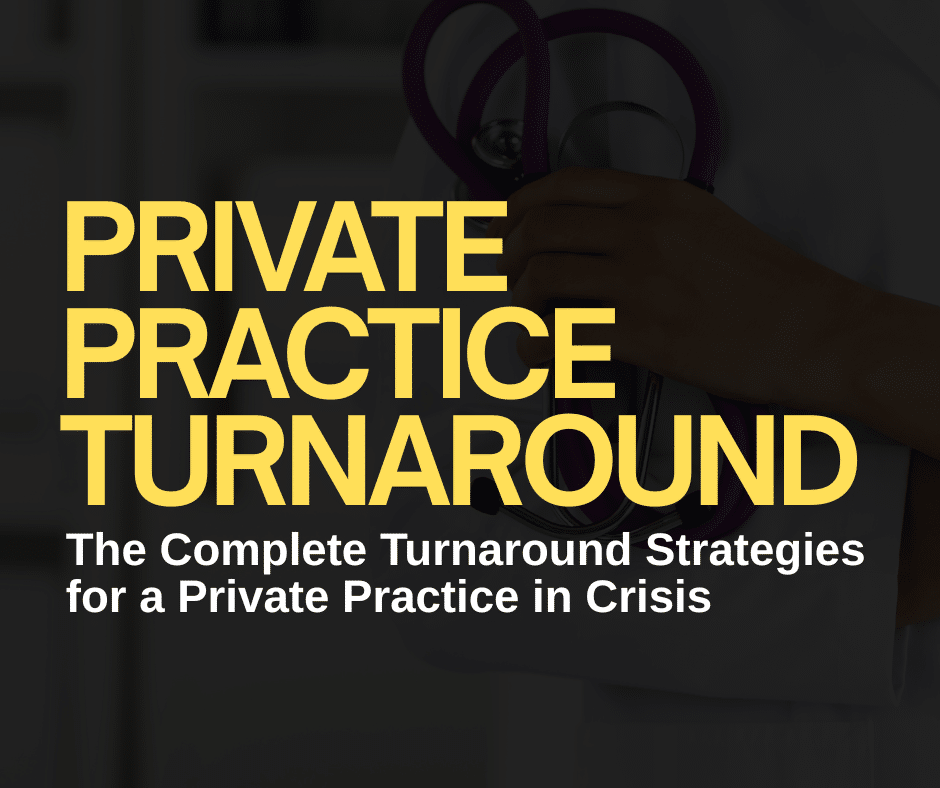Diving into this week’s blog topic of goal setting quickly showed me that there is no shortage of advice online for why to set goals, how to set goals, and tips on how to be successful.
My favorite tip and one that I thread throughout my work in EntreMD is, “Work smarter, not harder.” With time as one of our most precious commodities, being less busy and more productive is the goal we should aim for as we set goals.
 Example: Set up a sequence of activities to efficiently move patients through the clinical process with the goal of cutting down on time wasted by staff.
Example: Set up a sequence of activities to efficiently move patients through the clinical process with the goal of cutting down on time wasted by staff.
 Example: Attract more patients to your practice to grow your medical business.
Example: Attract more patients to your practice to grow your medical business.
 Example: Win “physician of the year” in my community.
Example: Win “physician of the year” in my community.
 Wisdom says that assessing the appropriate amount of effort for any given task will get you farther faster in achieving your goals. Is this activity worthy of an “A” effort? Can I still succeed without too much sacrifice if my effort is only a “B” or even a “C”?
Allowing yourself to assign a “C-level” effort to some tasks ensures you will have enough reserve to give the truly important tasks your best effort for the best outcome.
Wisdom says that assessing the appropriate amount of effort for any given task will get you farther faster in achieving your goals. Is this activity worthy of an “A” effort? Can I still succeed without too much sacrifice if my effort is only a “B” or even a “C”?
Allowing yourself to assign a “C-level” effort to some tasks ensures you will have enough reserve to give the truly important tasks your best effort for the best outcome.
 The Eisenhower Matrix, named after President Dwight D. Eisenhower, segments every task into one of four groups:
The Eisenhower Matrix, named after President Dwight D. Eisenhower, segments every task into one of four groups:
 Your goal should be clear and specific. When writing down your goal, answer any or all of these five relevant questions:
Your goal should be clear and specific. When writing down your goal, answer any or all of these five relevant questions:
 Example: Create a working document that includes every job description and responsibility needed to run your own medical practice properly.
Example: Create a working document that includes every job description and responsibility needed to run your own medical practice properly.
 Achievable goals answer questions like:
Achievable goals answer questions like:
 These questions will reveal whether your goal is truly relevant to you:
These questions will reveal whether your goal is truly relevant to you:
 Time-bound questions sound like these:
Time-bound questions sound like these:
 Design and articulate a vision for your practice and then enroll your staff to help you achieve it. With clear accountability measures, you and your staff can create a practice with healthier and happier patients, a community-wide reputation, and more revenue.
Work to apply the SMART framework to these three areas of your practice:
Design and articulate a vision for your practice and then enroll your staff to help you achieve it. With clear accountability measures, you and your staff can create a practice with healthier and happier patients, a community-wide reputation, and more revenue.
Work to apply the SMART framework to these three areas of your practice:
 Sample goals can be: “Hit 10,000 visits per year,” or “Increase procedures by 15 percent within six months.” Many actions might be necessary to achieve patient visit goals — increasing practice hours, hiring new staff, developing or expanding a patient referral system, or investing in marketing services.
Sample goals can be: “Hit 10,000 visits per year,” or “Increase procedures by 15 percent within six months.” Many actions might be necessary to achieve patient visit goals — increasing practice hours, hiring new staff, developing or expanding a patient referral system, or investing in marketing services.
 Working towards improving the flow of this visit, goals are set for better efficiency, such as, “Reduce the average length of time from reception sign-in to a provider exam by 15 percent.” The practice can also outline supporting objectives like developing a task list or investing in an electronic system that triggers alerts as patients move through each visit phase.
Working towards improving the flow of this visit, goals are set for better efficiency, such as, “Reduce the average length of time from reception sign-in to a provider exam by 15 percent.” The practice can also outline supporting objectives like developing a task list or investing in an electronic system that triggers alerts as patients move through each visit phase.
 Urgent care clinics’ goals can be to “Educate our patients about preventive care guidelines according to their risk factors.” The staff then researches clinical recommendations made by patients’ diagnostic categories, age, gender, and other factors.
Urgent care clinics’ goals can be to “Educate our patients about preventive care guidelines according to their risk factors.” The staff then researches clinical recommendations made by patients’ diagnostic categories, age, gender, and other factors.
 Below are examples I found on a recent Healthbridge site. While the categories are familiar, the author’s examples are so specific and timely I wanted to share them with you:
Below are examples I found on a recent Healthbridge site. While the categories are familiar, the author’s examples are so specific and timely I wanted to share them with you:
 Action plan: Send claims in real-time so that the patient is invoiced and can settle their bill before leaving the practice.
Measure of success: Reduce bad debt from 55% to 15% in three months.
Action plan: Send claims in real-time so that the patient is invoiced and can settle their bill before leaving the practice.
Measure of success: Reduce bad debt from 55% to 15% in three months.
 Action plan: Use automated benefit checks to access this information at the time of appointment, negating the need to call medical aids.
Measure of success: Have a 90% reduction in medical aid-related phone calls in two months.
Action plan: Use automated benefit checks to access this information at the time of appointment, negating the need to call medical aids.
Measure of success: Have a 90% reduction in medical aid-related phone calls in two months.
 Action plan: Use automated patients SMS reminders to remind patients of the appointment or screenings they have scheduled.
Measure of success: Realize a no-show rate of less than 5% in 5 months.
Action plan: Use automated patients SMS reminders to remind patients of the appointment or screenings they have scheduled.
Measure of success: Realize a no-show rate of less than 5% in 5 months.
 Action plan: Implement a cloud-based Electronic Medical Record (EMR) system that fully integrates with billing software and allows you to securely store and access patient & practice information from one digital platform.
Measure of success: Have zero paper patient files within three months.
I think one of the best books ever written is The 7 Habits of Highly Effective People. Along with his best-selling book, this guided journal offers worksheets and exercises to help you accomplish your short- and long-term goals. Stephen Covey not only offers principles on effectiveness, strategic planning, and how to turn ideas into action but uniquely highlights your personhood as you work towards accomplishing your goals.
Action plan: Implement a cloud-based Electronic Medical Record (EMR) system that fully integrates with billing software and allows you to securely store and access patient & practice information from one digital platform.
Measure of success: Have zero paper patient files within three months.
I think one of the best books ever written is The 7 Habits of Highly Effective People. Along with his best-selling book, this guided journal offers worksheets and exercises to help you accomplish your short- and long-term goals. Stephen Covey not only offers principles on effectiveness, strategic planning, and how to turn ideas into action but uniquely highlights your personhood as you work towards accomplishing your goals.
What’s in Your Control?
Setting goals is not as simple as deciding what you want to achieve, working hard enough, and then, presto: goals accomplished. It’s helpful to understand the amount of control you have with certain types of goals to adjust your expectations of what sheer grit and determination can accomplish.1. Process goals
These are specific performance actions or “processes” and are targets for what you do. Process goals are specific and actionable with a measurable outcome and are 100% in your control. Example: Set up a sequence of activities to efficiently move patients through the clinical process with the goal of cutting down on time wasted by staff.
Example: Set up a sequence of activities to efficiently move patients through the clinical process with the goal of cutting down on time wasted by staff.
2. Performance goals
These goals are short-term objectives tied to specific goals or responsibilities and are usually expressed in terms of personal achievement. They are based on personal standards and are mostly within your control. Example: Attract more patients to your practice to grow your medical business.
Example: Attract more patients to your practice to grow your medical business.
3. Outcome goals
Outcome goals focus on the end-point of an event and are based on winning. Achieving outcome goals is based not just on your performance and processes, but on outside factors not in your control. Simply focusing on outcome goals without drilling down into process and performance goals is less useful. Outcome goals are very difficult to control because of other outside influences. Example: Win “physician of the year” in my community.
Example: Win “physician of the year” in my community.
The A B C of Effort
While a lot has been written about goal setting, not every step along the path to achieving your goal deserves the same level of effort. As doctors and medical practitioners, many of us are predisposed to being perfectionists. We strive to be flawless, tend to set excessively high standards for ourselves, and can be overly critical of our work. The trouble with this drive towards perfectionism is when we require that every step we take along the path to achieving our goals be done with an “A” level of effort. My experience is that demanding this type of effort from myself is a sure way to burn out and delay accomplishing my goals. Wisdom says that assessing the appropriate amount of effort for any given task will get you farther faster in achieving your goals. Is this activity worthy of an “A” effort? Can I still succeed without too much sacrifice if my effort is only a “B” or even a “C”?
Allowing yourself to assign a “C-level” effort to some tasks ensures you will have enough reserve to give the truly important tasks your best effort for the best outcome.
Wisdom says that assessing the appropriate amount of effort for any given task will get you farther faster in achieving your goals. Is this activity worthy of an “A” effort? Can I still succeed without too much sacrifice if my effort is only a “B” or even a “C”?
Allowing yourself to assign a “C-level” effort to some tasks ensures you will have enough reserve to give the truly important tasks your best effort for the best outcome.
The Tyranny of the Urgent
An important consideration of any goal-setting advice is to beware of the tyranny of the urgent. This is when urgent tasks stop you from working on and completing more important activities, keeping you from being productive and achieving your goals. Urgent tasks are those that demand immediate attention. Activities like answering the phone and meeting deadlines, for example. The urgency of this type of task can fill our days and stop us from doing the work that truly gets us closer to our goals. The Eisenhower Matrix, named after President Dwight D. Eisenhower, segments every task into one of four groups:
The Eisenhower Matrix, named after President Dwight D. Eisenhower, segments every task into one of four groups:
- Important and urgent: Tasks that require immediate attention and help you achieve your goals. There are often consequences for not completing these tasks successfully and on time.
- Important but not urgent: Tasks that will help you achieve your career and life goals but don’t have an attached deadline. Becoming a keynote speaker will increase your authority in your field, but there probably isn’t an actual deadline to do so.
- Urgent but not important: Tasks that require immediate attention but don’t move you closer to your goals. Keeping an empty inbox may be urgent, but not every email is important.
- Neither urgent nor important: Tasks that do nothing to get you closer to your goals don’t demand immediate attention. That’s not to say taking a mental health break by reading a book, watching your favorite tv show, or scrolling through your Instagram feed doesn’t have value. These activities just don’t move you closer to fulfilling your goals.
The SMART Framework
This acronym stands for Specific, Measurable, Attainable, Relevant, and Time-Bound and is widely accepted as one of the best ways to set goals:1. Specific
 Your goal should be clear and specific. When writing down your goal, answer any or all of these five relevant questions:
Your goal should be clear and specific. When writing down your goal, answer any or all of these five relevant questions:
- What do I want to accomplish?
- Why is this goal important?
- Who is involved?
- Where is it located?
- Which resources or limits are involved?
2. Measurable
It’s critical to have measurable goals that allow you to track your progress and stay motivated. Measuring your progress helps you stay focused, meet your deadlines and feel the emotional reward of getting closer to achieving your goal. Example: Create a working document that includes every job description and responsibility needed to run your own medical practice properly.
Example: Create a working document that includes every job description and responsibility needed to run your own medical practice properly.
3. Attainable
Of course, your goal needs to be realistic and attainable to be successfully achieved. It should stretch your abilities but remain possible. Achievable goals answer questions like:
Achievable goals answer questions like:
- How can I accomplish this goal?
- How realistic is the goal, once I factor in constraints, such as financial outlay?
4. Relevant
You’ll want to make sure that your goal matters to you and that it aligns with other relevant goals. These questions will reveal whether your goal is truly relevant to you:
These questions will reveal whether your goal is truly relevant to you:
- Does this goal seem worthwhile?
- Is this the right time?
- Does this goal match our other efforts and needs?
- Am I the right person to reach this goal?
- Does this goal fit in the current socio-economic environment?
5. Time-Bound
Every goal needs a target date to help stay on track. Without a target date, the “tyranny of the urgent” tasks can soak up your time and leave you frustratedly far from accomplishing your goals. Time-bound questions sound like these:
Time-bound questions sound like these:
- What can I do six months from now to move closer to my goal?
- What can I do six weeks from now to move closer to my goal?
- What can I do today to move closer to my goal?
Your Medical Practices, Your Business
A thriving practice considers the health of every facet of the business. It’s not enough to be making payroll if the staff leak money by inefficient billing. It’s not enough for your patient satisfaction numbers to be high when your staff satisfaction numbers are low. To truly thrive requires all aspects of your practice to be healthy. Achieving that often requires asking yourself the questions listed above in the SMART framework. Design and articulate a vision for your practice and then enroll your staff to help you achieve it. With clear accountability measures, you and your staff can create a practice with healthier and happier patients, a community-wide reputation, and more revenue.
Work to apply the SMART framework to these three areas of your practice:
Design and articulate a vision for your practice and then enroll your staff to help you achieve it. With clear accountability measures, you and your staff can create a practice with healthier and happier patients, a community-wide reputation, and more revenue.
Work to apply the SMART framework to these three areas of your practice:
Patient Visits
No medical practice can be successful without patients. A successful practice should aim to reach its optimal number of patients and steadily increase patient numbers. Sample goals can be: “Hit 10,000 visits per year,” or “Increase procedures by 15 percent within six months.” Many actions might be necessary to achieve patient visit goals — increasing practice hours, hiring new staff, developing or expanding a patient referral system, or investing in marketing services.
Sample goals can be: “Hit 10,000 visits per year,” or “Increase procedures by 15 percent within six months.” Many actions might be necessary to achieve patient visit goals — increasing practice hours, hiring new staff, developing or expanding a patient referral system, or investing in marketing services.
Workflow Efficiency
Healthy medical practices plan a deliberate set of activities to efficiently move patients through the clinical process. They start with welcoming the patient and gathering their health care information. They are then taken to a sanitized and prepared consultation room for their visit with the doctor. The doctor sees the patient and writes up any necessary next-step procedures and medications. The patient then leaves the clinic. Working towards improving the flow of this visit, goals are set for better efficiency, such as, “Reduce the average length of time from reception sign-in to a provider exam by 15 percent.” The practice can also outline supporting objectives like developing a task list or investing in an electronic system that triggers alerts as patients move through each visit phase.
Working towards improving the flow of this visit, goals are set for better efficiency, such as, “Reduce the average length of time from reception sign-in to a provider exam by 15 percent.” The practice can also outline supporting objectives like developing a task list or investing in an electronic system that triggers alerts as patients move through each visit phase.
Quality of Care
A good medical practice delivers comprehensive and high-quality care. Medical directors and medical practitioners focus on improving activities such as reducing any duplication of services, meeting clinical guidelines, and quality assurance. Urgent care clinics’ goals can be to “Educate our patients about preventive care guidelines according to their risk factors.” The staff then researches clinical recommendations made by patients’ diagnostic categories, age, gender, and other factors.
Urgent care clinics’ goals can be to “Educate our patients about preventive care guidelines according to their risk factors.” The staff then researches clinical recommendations made by patients’ diagnostic categories, age, gender, and other factors.
Health Outcomes
Medical practices also are key settings for improving patients’ health outcomes. It’s common to set goals to reduce the incidence of certain symptoms or conditions. For instance, a primary care practice decides upon the following goals for sufferers of cardiovascular disease: “Decrease cholesterol levels among 33 percent of patients and decrease blood pressure levels among 40 percent of patients.” A primary care practice might generally seek to reduce hospital admissions or emergency room visits for its entire patient population. Below are examples I found on a recent Healthbridge site. While the categories are familiar, the author’s examples are so specific and timely I wanted to share them with you:
Below are examples I found on a recent Healthbridge site. While the categories are familiar, the author’s examples are so specific and timely I wanted to share them with you:
1. Financial goals
Example: Outstanding invoices are negatively impacting your cash flow and profitability. Goal: Decrease bad debt as a result of timely patient collections. Action plan: Send claims in real-time so that the patient is invoiced and can settle their bill before leaving the practice.
Measure of success: Reduce bad debt from 55% to 15% in three months.
Action plan: Send claims in real-time so that the patient is invoiced and can settle their bill before leaving the practice.
Measure of success: Reduce bad debt from 55% to 15% in three months.
2. Staff goals
Example: Staff is spending too much time calling medical aids retrospectively to confirm patient benefits. Goal: Decrease the number of phone calls staff makes to medical aids to confirm benefits. Action plan: Use automated benefit checks to access this information at the time of appointment, negating the need to call medical aids.
Measure of success: Have a 90% reduction in medical aid-related phone calls in two months.
Action plan: Use automated benefit checks to access this information at the time of appointment, negating the need to call medical aids.
Measure of success: Have a 90% reduction in medical aid-related phone calls in two months.
3. Patient goals
Example: Patients are regularly not arriving for their scheduled appointments or routine follow-ups. Goal: Reduce the number of patient no-shows. Action plan: Use automated patients SMS reminders to remind patients of the appointment or screenings they have scheduled.
Measure of success: Realize a no-show rate of less than 5% in 5 months.
Action plan: Use automated patients SMS reminders to remind patients of the appointment or screenings they have scheduled.
Measure of success: Realize a no-show rate of less than 5% in 5 months.
4. Physical surrounding goals
Example: Paper files are taking up too much space in your practice and preventing you from creating an additional consulting room. Goal: To be a fully paperless practice Action plan: Implement a cloud-based Electronic Medical Record (EMR) system that fully integrates with billing software and allows you to securely store and access patient & practice information from one digital platform.
Measure of success: Have zero paper patient files within three months.
I think one of the best books ever written is The 7 Habits of Highly Effective People. Along with his best-selling book, this guided journal offers worksheets and exercises to help you accomplish your short- and long-term goals. Stephen Covey not only offers principles on effectiveness, strategic planning, and how to turn ideas into action but uniquely highlights your personhood as you work towards accomplishing your goals.
Action plan: Implement a cloud-based Electronic Medical Record (EMR) system that fully integrates with billing software and allows you to securely store and access patient & practice information from one digital platform.
Measure of success: Have zero paper patient files within three months.
I think one of the best books ever written is The 7 Habits of Highly Effective People. Along with his best-selling book, this guided journal offers worksheets and exercises to help you accomplish your short- and long-term goals. Stephen Covey not only offers principles on effectiveness, strategic planning, and how to turn ideas into action but uniquely highlights your personhood as you work towards accomplishing your goals.
“If you aim for nothing, you’ll hit it every time.”So, this week, I’ve done the research for you when it comes to the best information on goal setting. If I can help you in other ways to become the entrepreneur of your medical business or your life, please contact me. I would love to talk with you!

